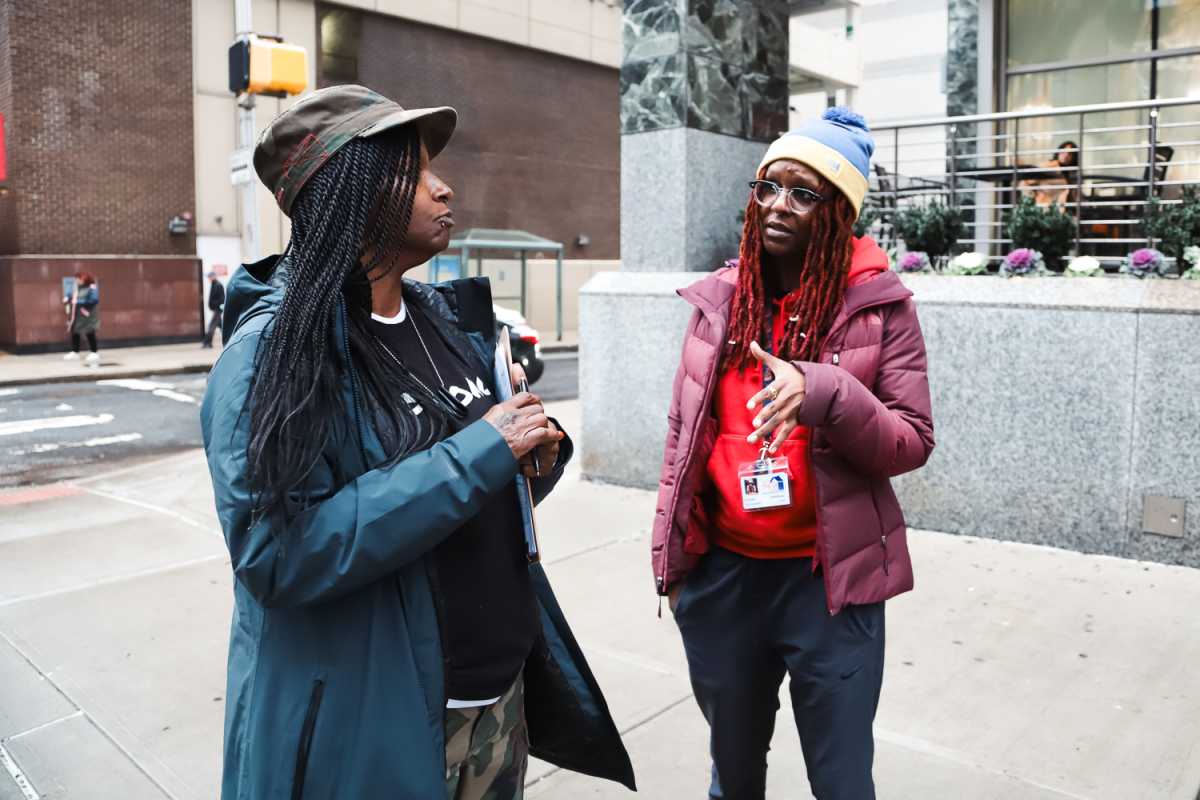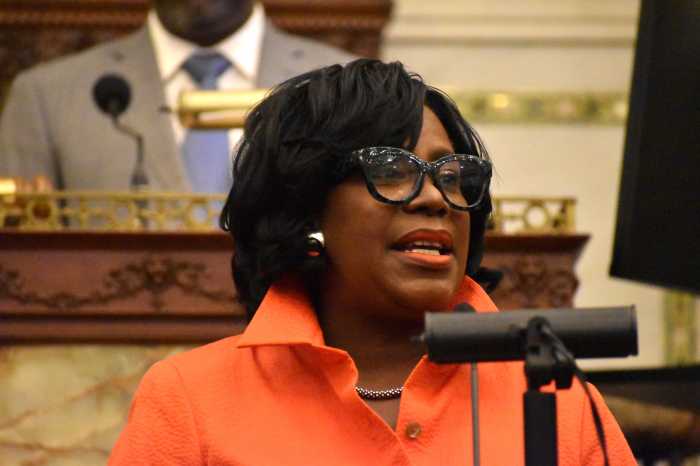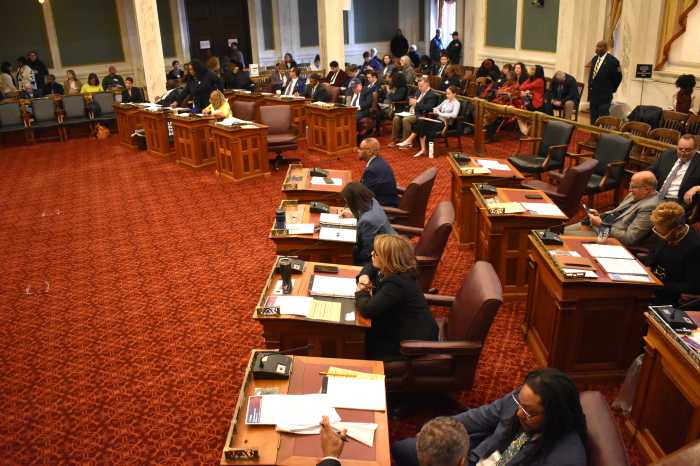David Weathington bent over late Wednesday night to speak to a homeless man across the street from City Hall, while Anthony Warren grabbed gloves and foot warmers out of a hefty supply bag.
The man, who was crouched in his wheelchair, had just thrown up onto a sandwich placed into his lap by a passerby. Yet, in a soft tone, he answered Weathington’s questions, and the pair put a $5 Wawa gift card in his pocket.
He was the first unsheltered person approached overnight by Weathington and Warren as part of the 2024 Point-in-Time, or PIT, Count, an annual census of people living on the street.
More than 300 volunteer surveyors set out from Love Park at around 11 p.m. Wednesday. They were dispatched to dozens of zones in every section of the city, each carrying a map with known “hot spots” where homeless individuals and families congregate. The operation stretched into the early morning hours.
Using a questionnaire, the volunteers gathered information about the unsheltered population and tallied those who were sleeping or declined to complete the survey. As an incentive, anyone who answered the questions received a gift card.
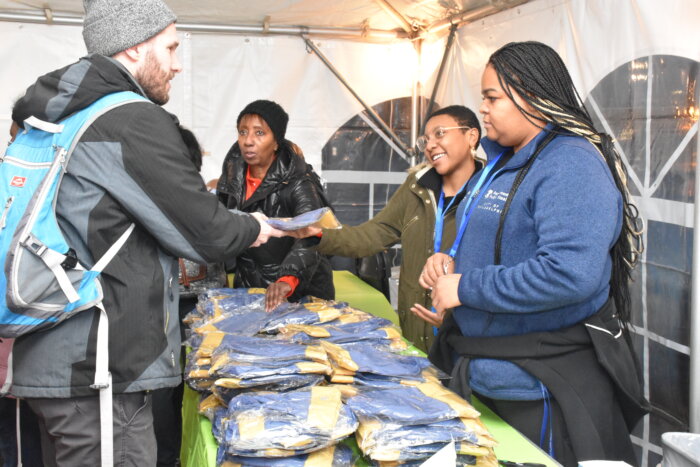
PIT counts are mandated by the U.S. Department of Housing and Urban Development and conducted in January all over the country, in cities and rural communities. The data, along with a similar count inside shelters and other emergency housing facilities, supplements numbers tracked by homeless service agencies and nonprofits.
“This is how we gauge the size of the challenge before us,” Matthew Heckles, the HUD regional administrator based in Philadelphia, told the crowd of counters from a raised stage at Love Park. “Without this work tonight, we don’t know what progress we’re making, and we don’t know what work we have left to do. And that drives money. It drives funding from Congress.”
Numbers from Wednesday’s count, along with a special youth tally the following afternoon, will not be available for months, according to the city’s Office of Homeless Services.
In January 2023, the count found 4,725 unhoused people, an increase of 236 from the year before and a 423-person spike compared to 2021. However, in the years prior, PIT count totals were usually above 5,500.
Of those tallied, 85% were indoors, meaning they were sleeping in a shelter, transitional unit or safe haven. The number of people counted on the street has fallen significantly – around 25% – in the last five years, according to OHS data.
PIT counts have well-known flaws. They only represent a single night, and volunteers do not venture into abandoned properties. The census also does not incorporate those temporarily staying with a friend, family member or acquaintance, also known as ‘couch surfing.’
“It’s not an accurate count,” said Beth Gonzales, the OHS deputy who organizes the PIT count. “It’s just kind of a guesstimate.”

Significant racial disparities exist in the homeless population, both nationally and locally. Of those included Philadelphia’s 2023 PIT Count, 68% were Black, 25% were white, and 11% were Latino.
Nearly 18,000 people received services related to homelessness in the 2022 fiscal year – the most recent information available – and 78% of those individuals were Black, OHS data indicates. About 40% of the city’s population is Black.
Almost a third of the people surveyed in last year’s PIT count reported a serious mental illness and 24% said they had a substance use disorder, including more than half of the 706 unsheltered individuals.
For 43% of people who entered a shelter on the night of the 2023 count, it was their first time being homeless, OHS officials said.
“Coming out of the pandemic, we’re starting to see different faces,” OHS Executive Director David Holloman told Metro. “We’re definitely seeing people who would traditionally be able to afford their rent not being able to afford those rents.”
On the other side of the spectrum are the chronically homeless, which HUD defines as someone who has been on the street for at least a year or has been unsheltered four or more times in the past three years.
Just over 1,000 people, or 22%, of those tallied in the 2023 PIT Count met the definition for chronically homeless.
A man surveyed Wednesday night near Reading Terminal Market told Weathington he has been homeless for nearly 50 years, and another reported being on the streets since 1996, which he credited partially to a mental health misdiagnosis.
Anthony Clark, 41, who was approached outside the Pennsylvania Convention Center, said he has been homeless since he was 15 years old. He believes he has been passed over for permanent housing opportunities.
“I wouldn’t be out here” if I had an apartment, Clark said. “When it comes to my turn, y’all ran out of money.”
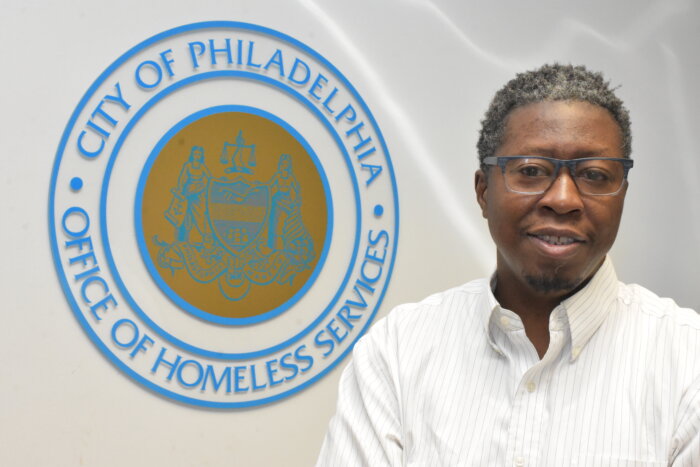
Nationally, HUD’s Annual Homelessness Assessment Report, released last month, shows a 12% increase in homelessness from 2022 to 2023. The report documented about 653,000 homeless individuals, the highest total since PIT count data began being collected in 2007.
Several cities, including Seattle, San Diego and Denver, counted more than double the number of homeless individuals in Philadelphia’s PIT count. Los Angeles’s tally found about 71,000 people – 73% of whom were unsheltered.
“We’re so close,” said Tina Pagotto, chief executive officer of Bethesda Project, which operates a large shelter and seven supportive housing sites. “Talking about under a thousand people that are on the streets, that’s manageable. If the resources were infused, I think that is a manageable problem.”
While data is valuable, Gonzales, of OHS, told Metro that there is a “lag” with the numbers. By the time trends are reflected in the data, they have probably been occurring for months or years.
More anecdotally, homeless service providers say rising housing costs, inflation and the expiration of many pandemic-era benefits is driving homelessness.
Rents have increased 7% over the past year in the Philadelphia region, according to statistics compiled by the Federal Reserve Bank of St. Louis.
“What people say is, they simply can’t afford it,” said Candice Player, vice president of advocacy, public policy and street outreach at Project HOME. “They can’t afford first, last month, security – all of the startup costs to get into a rental apartment.”
A 2020 U.S. Government Accountability Office analysis found that a $100 increase in median rent was associated with a 9% increase in homelessness, even when accounting for other factors.
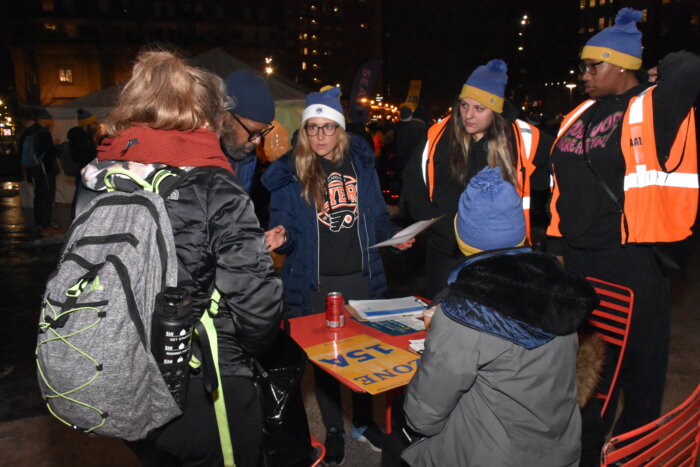
Pandemic measures, including rental assistance, the eviction moratorium, the Child Tax Credit, stimulus checks and other benefits, halted a rise in homelessness between 2020 and 2022, wrote Jeff Olivet, executive director of the U.S. Interagency Council on Homelessness, wrote in a December message. But, with federal COVID-19 money mostly gone, homelessness is trending up again.
“Those benefits were life savers for many of the individuals that we’re serving,” Holloman, the OHS executive director, said. “Now that those benefits have evaporated, we’re starting to see the direct impact of that.”
The Salvation Army of Greater Philadelphia’s after-hours intake center has seen a surge of people in need, said Kelly Devlin, the organization’s director of social service ministries. During the height of the pandemic, two to four families came in; now, the center sees 20 to 40, double the pre-COVID number, she said.
“Our families were able to utilize those stimulus checks to move out of shelter,” Devlin added. “And put a little nest egg aside so that they could continue to pay their rent while they were working on getting that better-paying job.”
Pagotto, of Bethesda Project, compared the current shelter situation to a clogged pipe. Emergency housing is meant to be a short-term remedy, during which unhoused individuals are given access to affordable apartments and homes. There simply are not enough units, she said.
“At the end of the day, it’s not a mystery of what solves homelessness. Affordable housing solves homelessness,” Pagotto added. “When you’ve got enough affordable housing for people, homelessness doesn’t happen at a rapid rate.”

‘Housing For All’ is a two-year project in which Metro Philadelphia will investigate the city’s affordable housing crisis. It is made possible by The Lenfest Institute for Journalism’s Philadelphia Local News Sustainability Initiative grant.



